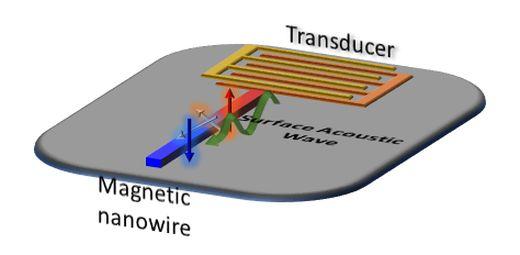Strain and Spintronics
 We are investigating using surface acoustic waves generated on a piezo electric substrate to manipulate the motion of magnetic domain walls.
We are investigating using surface acoustic waves generated on a piezo electric substrate to manipulate the motion of magnetic domain walls.
There is currently great interest in the development of solid-state magnetic data storage devices due to the limitations in speed and durability created by the moving parts in conventional hard disk drives, and by materials challenges in FLASH-based devices. Solid-state nanomagnetic devices have the potential to operate faster than both FLASH and conventional hard disks, and will not suffer from either mechanical fatigue or decay in electrical properties with repeated write cycles. Consequently, several device architectures have been developed: magnetic random access memory (MRAM), a non-volatile alternative to conventional random access memory (RAM), in which data are encoded in the magnetisation configuration of discrete nano-islands; and racetrack memory, in which data are represented by the positions of domain walls (DWs) in continuous nanowire conduits. Logic circuits based on nanomagnets have also been proposed, and promise new energy-efficient computer architectures that are inherently non-volatile. Furthermore, novel devices that exploit spin-waves (high frequency magnetic oscillations) have the potential to create low-power "magnonic" computing technologies.
In all the devices described above operations are performed by flowing electric currents, either to create magnetic fields or to directly affect the devices magnetisation through "spin-torque" effects. However, this creates heat, which lowers device efficiency. As an alternative, "composite multi-ferroic" devices have been proposed where voltages applied to piezoelectric substrates cause mechanical strains that manipulate the magnetisation of stress-sensitive magnetic layers fabricated on top of them. Current flow is then limited to that required to charge the piezoelectric layers, making such devices inherently attractive from the perspective of power efficiency.
There have been numerous studies of composite multi-ferroic systems, however most have applied stresses over long timescales (seconds to minutes), with few exploring the shorter timescale excitations (of the order of nanoseconds) that would be required in real memory or logic devices. Furthermore, where dynamic studies have been performed, these have typically used stress pulses. However, piezoelectric substrates also support continuous surface acoustic waves (SAWs) that have exciting properties from the perspective of device applications:
- SAWs can be electrically induced using interdigitated transducers (IDTs) and propagate over distances up to centimetres with little loss thus allowing SAWs to act on large numbers of devices in simple and scalable device architectures.
- SAWs have frequencies that are well matched to those of spin-waves, thus potentially allowing more efficient excitation of high frequency rmagnetisation dynamics.
- Coherent SAWs may be interfered to create standing waves, allowing spatially varying interaction landscapes to be created without complex lithography.
Despite these exciting features, there been relatively few studies into the functionality of SAWs in composite multi-ferroics, and those that have been performed have focused on extended thin films rather than device-relevant nanostructures. In this project, we will combine experiments and numerical modelling at the Universities of Sheffield and Leeds to develop a new framework for the control of magnetisation dynamics in composite multi-ferroic devices using electrically-induced surface acoustic waves (SAWs).
